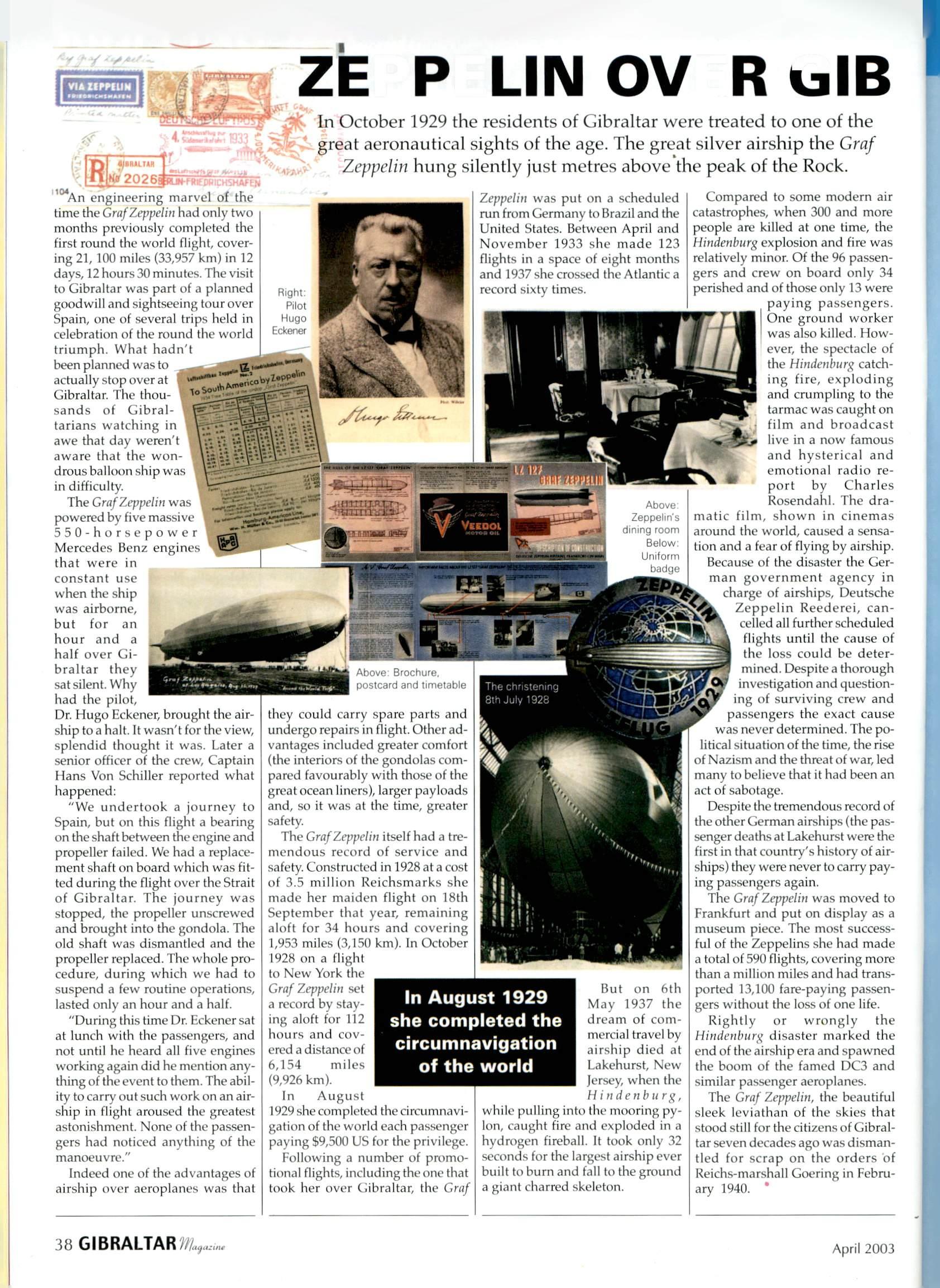
3 minute read
ZE P LIN OV R olB
^ In October 1929 the residents of Gibraltar were treated to one of the 2 great aeronautical sights of the age. The great silver airship the Graf V, Zeppelin hung silently just metres above the peak of the Rock.
An engineering marvel of the time the GrafZeppelin had only two months previously completed the first round the world flight, cover ing 21, 100 miles(33,957 km)in 12 days,12 hours30 minutes.The visit to Gibraltar was part of a planned goodwill and sightseeing tour over Spain, one of several trips held in celebration of the round the world triumph. What hadn't been planned was to actually stop over at Gibraltar. The thousands of Gibraltarians watching in awe that day weren't aware that the won drous balloon ship was in difficulty.
The GrafZ-cppelin was powered by five massive 550-horsepower Mercedes Benz engines that were in constant use when the ship was airborne, but for an hour and a half over Gi braltar they sal silent. Why had the pilot.
Dr. Hugo Eckener, brought the air ship to a halt. It wasn't for the view, splendid thought it was. Later a senior officer of the crew. Captain Hans Von Schiller reported what happened;
"We undertook a journey to Spain, but on this flight a bearing on the shaft between the engine and propeller failed. We had a replace ment shaft on board which was fit ted during the flight over the Strait of Gibraltar. The journey was stopped, the propeller unscrewed and brought into the gondola. The old shaft was dismantled and the propeller replaced. The whole pro cedure, during which we had to suspend a few routine operation.s, lasted only an hour and a half.
"During this time Dr. Eckener sat at lunch with the passengers, and not until he heard all five engines working again did he mention any thing of the event to them.The abil ity to carry outsuch work on an air ship in flight aroused the greatest astonishment. None of the passen gers had noticed anything of the they could carry spare parts and undergo repairs in flight. Other ad vantages included greater comfort (the interiors of the gondolas com pared favourably with those of the great ocean liners),larger payloads and, so it was at the time, greater safety.
The GrafZeppelin itself had a tre mendous record of service and safety. Constructed in 1928 at a cost of 3.5 million Reichsmarks she made her maiden flight on 18th September that year, remaining aloft for 34 hours and covering 1,953 miles (3,150 km). In October 1928 on a flight to New York the Graf Zeppelin set a record by stay ing aloft for 112 hours and cov ered a distance of 6,154 miles (9,926 km).
In August 1929 she completed the circumnavigation of the world
In August 1929she completed the circumnavi gation of the world each passenger paying $9,500 US for the privilege.
Following a number of promo tional flights,including the one that took her over Gibraltar, the Graf
Above Zeppelin's dining room
Below:
Zeppelin was put on a scheduled run from Germany to Brazil and the United States. Between April and November 1933 she made 123 flights in a space of eight months and 1937 she crossed the Atlantic a record sixty times. manoeuvre.
Compared to some modern air catastrophes, when 300 and more people are killed at one time, the Hindenburg explosion and fire was relatively minor. Of the 96 passen gers and crew on board only 34 perished and of those only 13 were paying passengers. One ground worker was also killed. How ever, the spectacle of the Hindenburg catch ing fire, exploding and crumpling to the tarmac was caught on film and broadcast live in a now famous and hysterical and emotional radio re port by Charles Rosendahl. The dra matic film, shown in cinemas around the world, caused a sensa tion and a fear of flying by airship.
Because of the disaster the Ger man government agency in charge of airships, Deutsche Zeppelin Reederei, can celled all further scheduled flights until the cause of the loss could be deter mined.Despite a thorough investigation and question ing of surviving crew and passengers the exact cause was never determined.The po litical situation of the time,the rise of Nazism and the threat of war,led many to believe that it had been an act of sabotage.
Despite the tremendous record of the other German airships(the pas senger deaths at Lakehurst were the first in that country's history of air ships)they were never to carry pay ing passengers again.
The Graf Zeppelin was moved to Frankfurt and put on display as a museum piece. The most success ful of the Zeppelins she had made a total of590 flights,covering more than a million miles and had trans ported 13,100 fare-paying passen gers without the loss of one life.
Rightly or wrongly the Hindenburg disaster marked the end of the airship era and spawned the boom of the famed DC3 and similar passenger aeroplanes.
38 GIBRALTAR April 2003
The Gibraltar School ofBallet
Lflis Acwbia • Boiiv Conditioning Unit F19 Europe Business Centra Tel:(home)51187 (studio)45145 E-maii'










